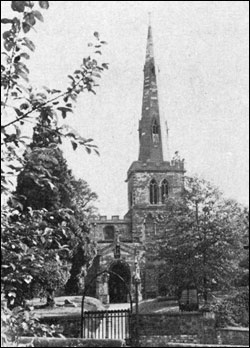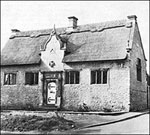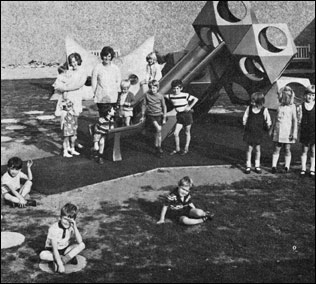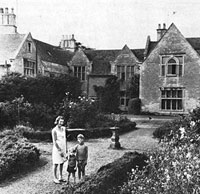| Article from Northamptonshire Life Magazine October 1973 transcribed by Raylee Burton |
||||||||||||
|
||||||||||||
| Jennifer Crwys Williams Visits
Burton Latimer, which spreads itself above the valley through which runs the River Ise, can almost be divided into three sections. There are streets lying near the Parish Church of St Mary the Virgin, in which old houses, built of deep cream stone, lie cheek by jowl; further up the low rise of the hill the more modern section, dating from Victorian times and built predominantly of a dark red brick, extends along the main shopping road. In between the dark Victorian brick, the clean lines of modern buildings stand out, their lines emphasised by lighter brick and wide, deep windows.
There are two thickly studded doors leading into the Church, which was fully restored in 1972, and is in pristine condition. The Church is a simple one with a high arched roof and a long nave. There are two altars, one set on a slightly raised dais immediately in front of the fine chancel screen, the second altar in the more traditional position beyond the choir. Both altars have modern altar cloths, done in the form of an abstract collage, in which the predominant colours of the Church have been echoed. The altar cloth near the chancel screen is mainly a deep, pine green, as is the carpet which surrounds the altar. In the first two rows of pews, needlework kneelers have been made with a design of gold and white crosses on a pine green background. The second altar, surrounded by a light gold carpet, is covered in a cloth worked in gold and creams. There is a fine brass to Margaret Bacon, who died in 1626 and nearby, on the same wall, a memorial window to the dead of the First World War with a named tablet beneath. A smaller tablet commemorates the dead of the Second World War. There are also two old chests, a Jacobean one and a poor box. However, what set St Mary the Virgin apart from other churches, are its rare wall paintings. It is difficult to imagine how colourful the churches were in the days of our forefathers, with their beautifully daubed walls and pillars - we only see an echo of them. But here, in Burton Latimer, sitting beneath these exquisite paintings, it is easier to imagine not only how the churches looked, but also to understand how important these works of art must have been in an age of almost total illiteracy. There are twelve paintings of the twelve patriarchs, three of which are mostly obliterated. These paintings, executed in about 1600, are perhaps more immediately recognisable than the other three, which are on the north wall. These, dating from 1300, are of the life and martyrdom of St. Catherine, and have all the awkward exuberance of early mediaeval paintings. All the paintings have been magnificently restored by Eve Baker, AR There is also a very modern Catholic Church on the
Jacobean House, on the opposite side and further down the road from St. Mary the Virgin, is a converted school house. A tablet over the door reads: 'This house was built in 1622. The free school was founded by Thomas Banke and Margaret his wife'. Opposite Jacobean House is St Mary's Primary School, which was founded in 1581. In addition to this school, the village has a newly-built Infants' School and a separate
In One is the more traditional, comprising swings, a roundabout and a rocking horse and the second, in a walled-in area of its own, is designed for even younger children, and has variously shaped apparatus, through which the children can crawl, slide, run, leap or whatever. There are benches supplied for exhausted mothers and even an artificial, slightly padded lawn set beneath one of the more elaborate toys - a boon with winter mud and perhaps preventing a grazed knee. It is always encouraging to find areas like this set aside specifically for the very young; let loose amongst older children and running between flying swings, accidents are frequent and inevitable. There is a second recreational area at the end of There are several clubs in Burton Latimer, among which are the Burton Latimer Band Club, the Britannia Club, the Finedon and Working Men's Club and the Conservative Club, which appears to share its premises with the Royal Engineers and numerous barrels of Guinness. The chief industry in Burton Latimer is the manufacture of boots and shoes, with a tannery as a natural ancillary. Weetabix Ltd has its main factory here, and the other large factory belongs to Alumasc, who specialise in the manufacture of low pressure die casting in silicon aluminium; perhaps the best known of their products being lightweight beer barrels and waste disposal units. It is estimated that approximately 50% of the people employed in industry in Burton Latimer come from outside the village. Only about 3% of the working population of the village are actually looking for work and as things alter so quickly in these days, the figures quoted may have altered by the time this appears in print.
There are two notable houses, the Manor House, which is set amidst large and shady trees, immediately next to the parish church and Burton Latimer Hall on the On the road to Thrapston, a short way out of Burton Latimer, but still within the district boundary, is a curious, rather gaunt round house. General Arbuthnot, who lived at the nearby Woodford House, built the tower after the Duke of Wellington, who was visiting him, mentioned that the countryside reminded him of the land around Burton Latimer is in the midst of change and I have no doubt that with its progressively thinking council it will make the transition from old to modern in the most natural manner possible. |
||||||||||||



